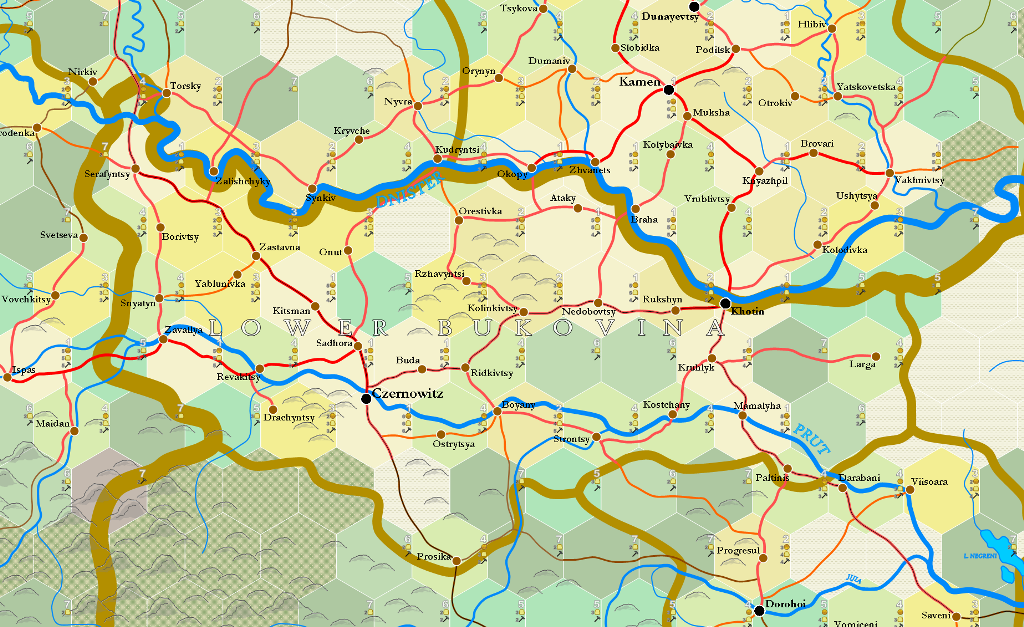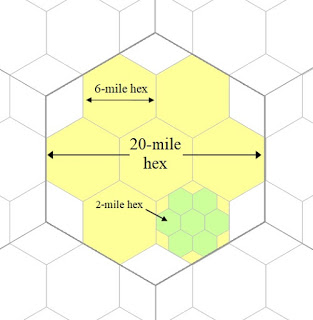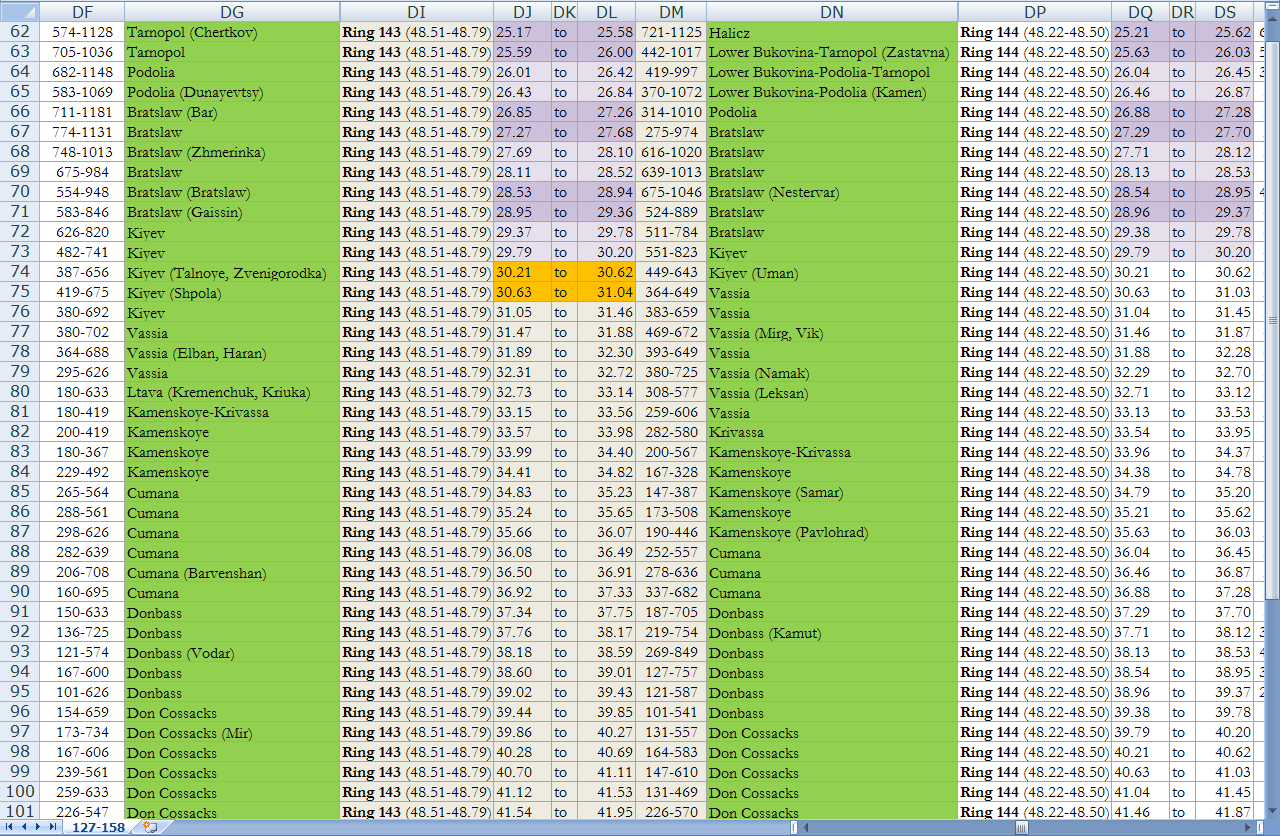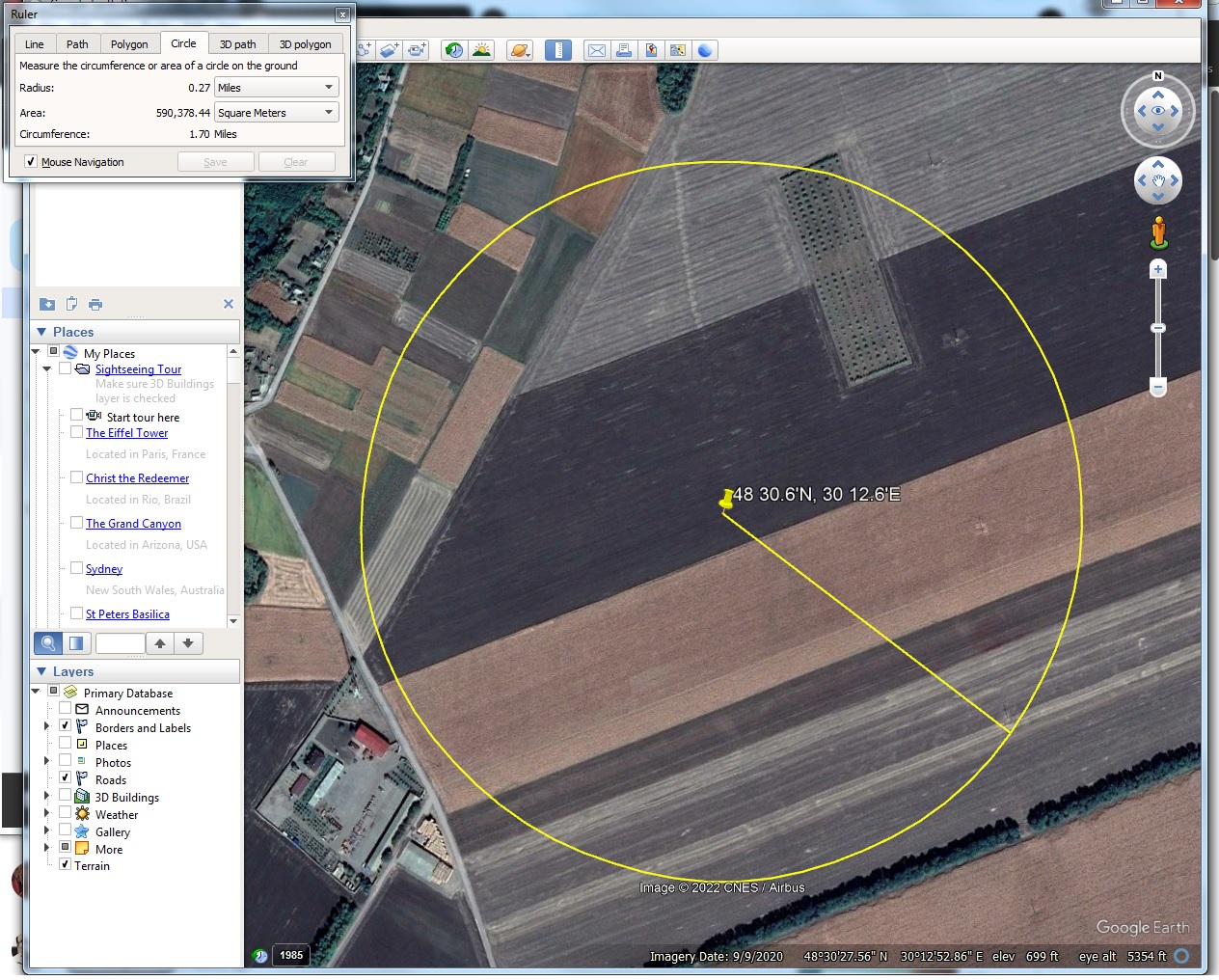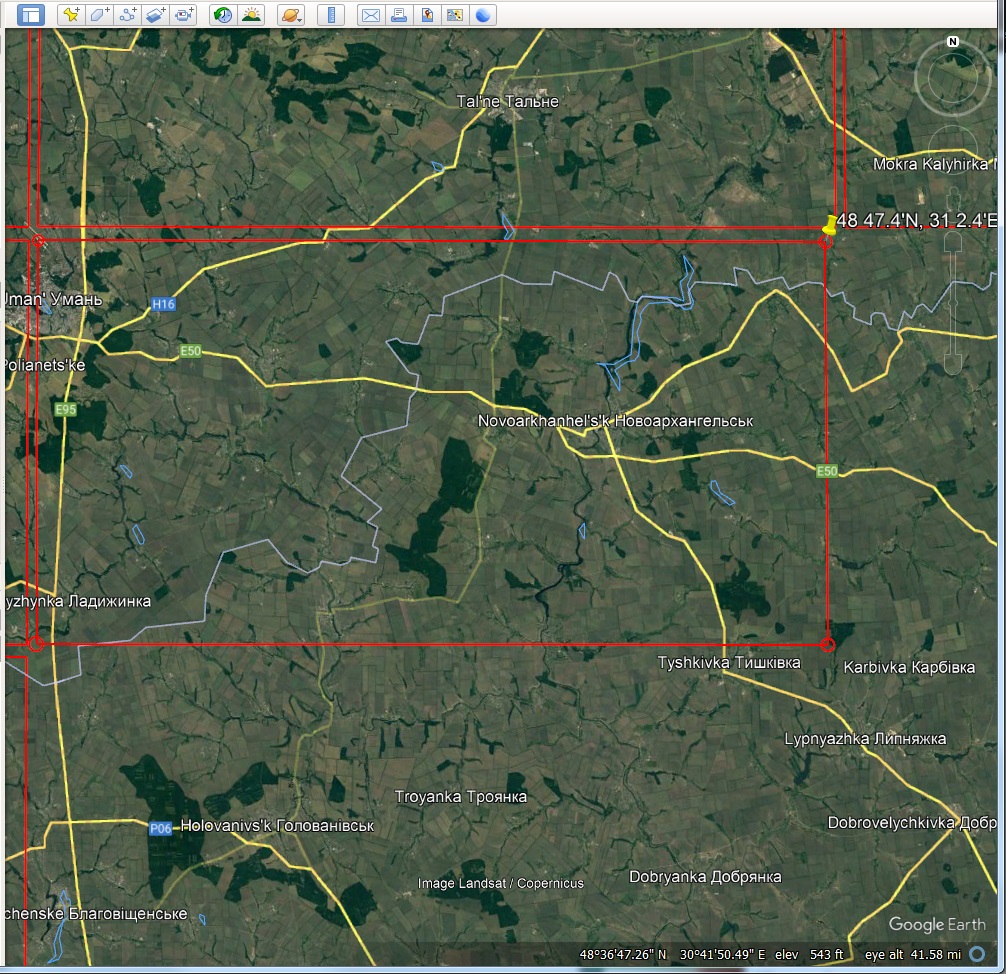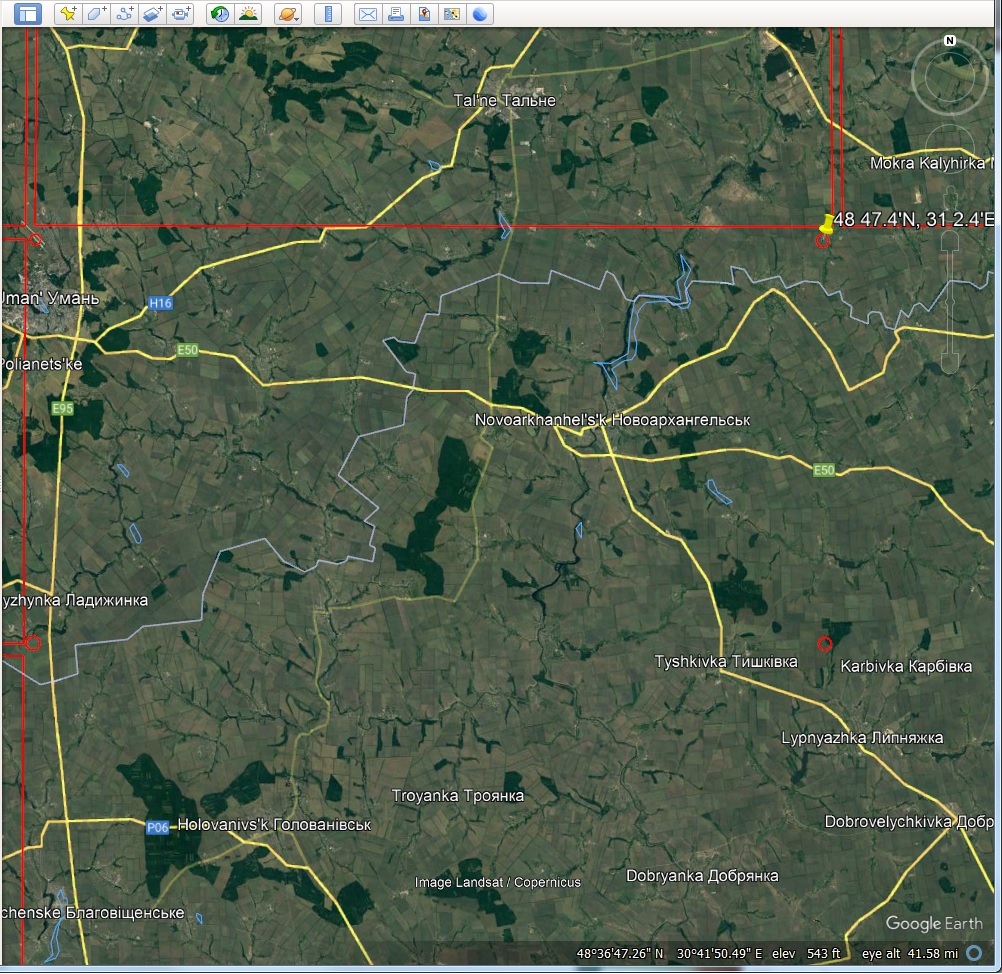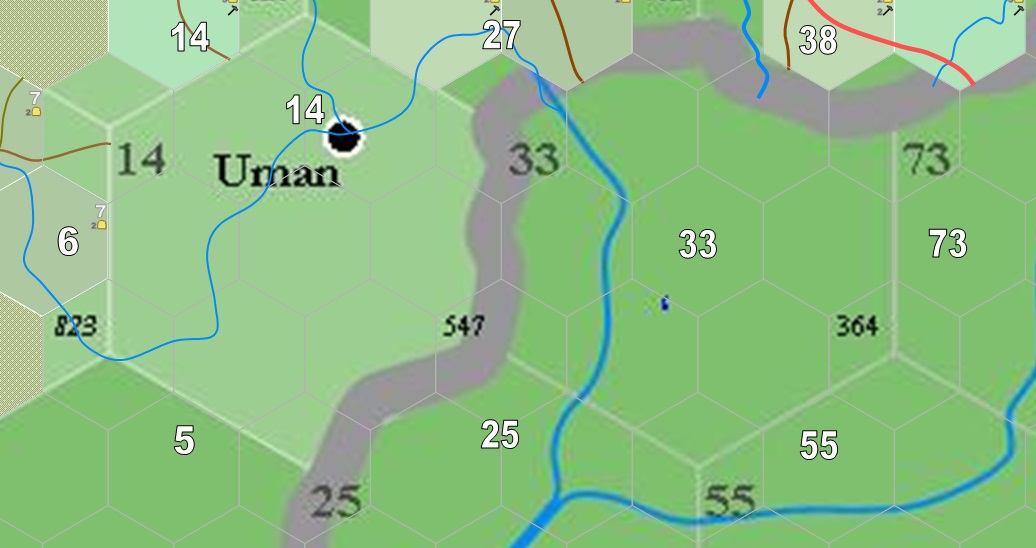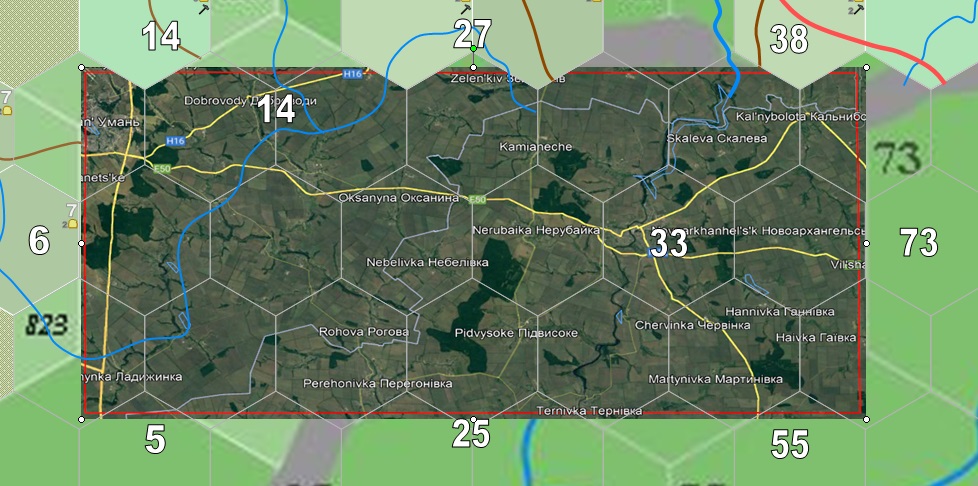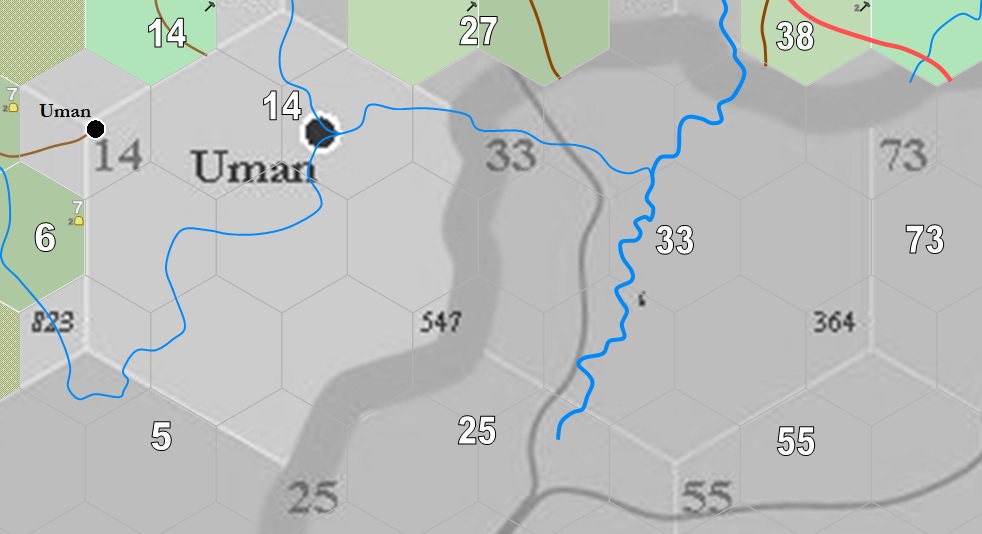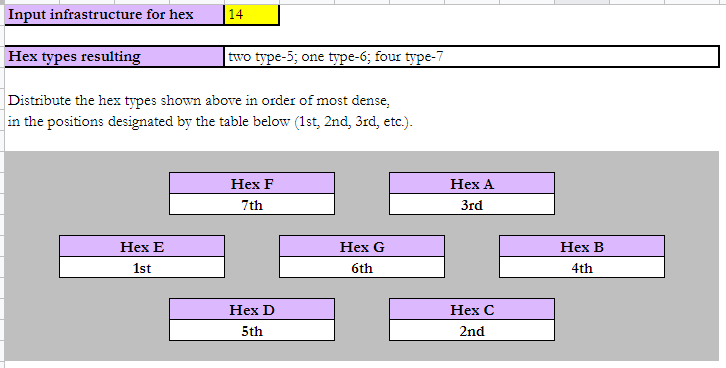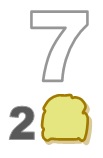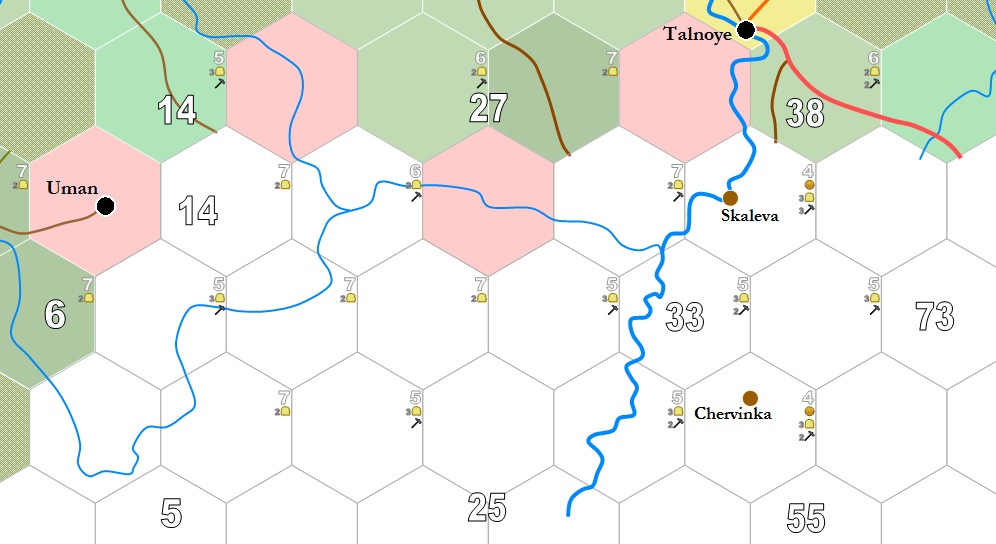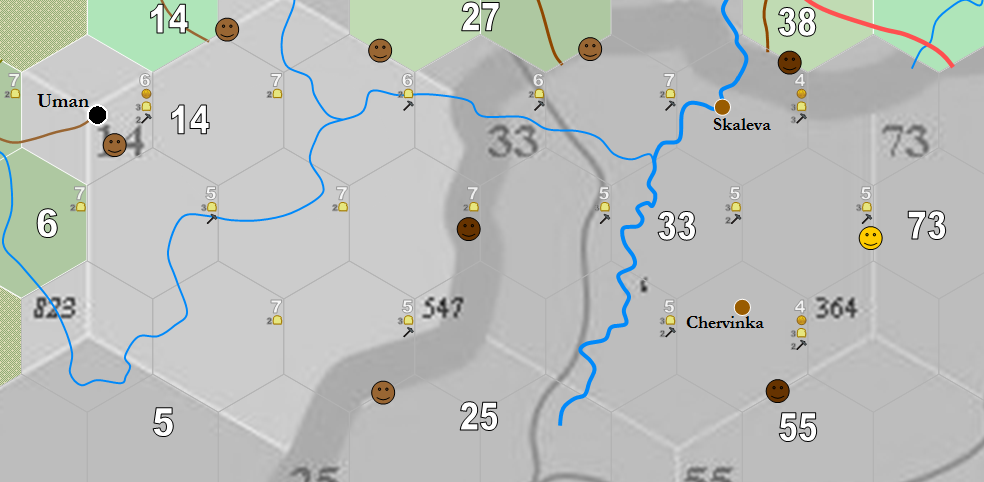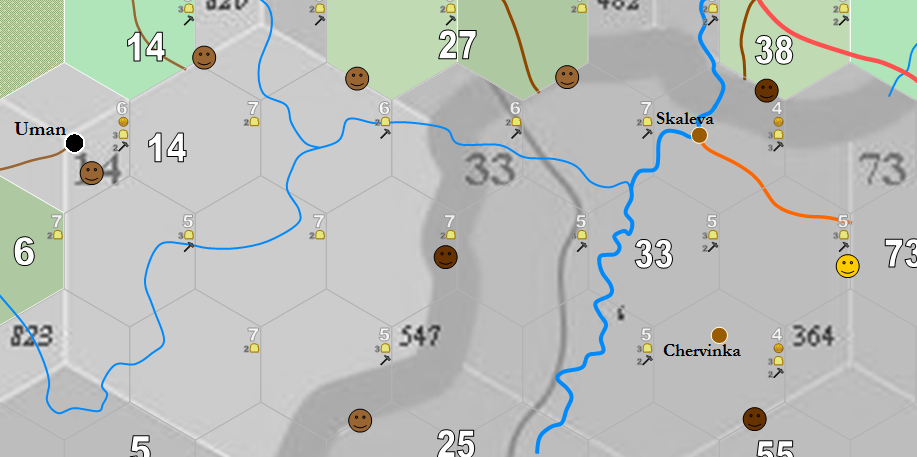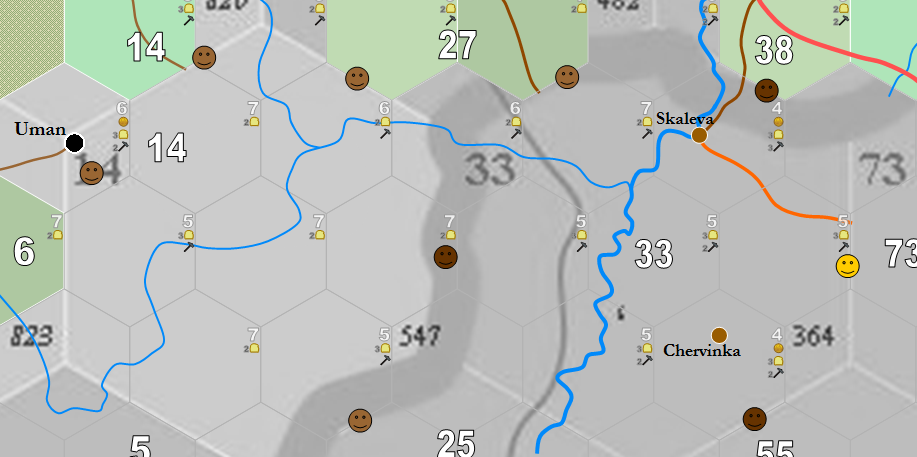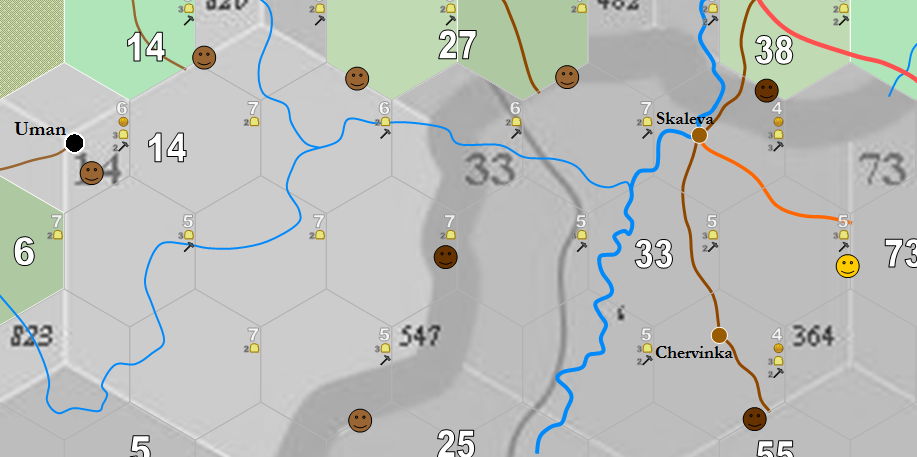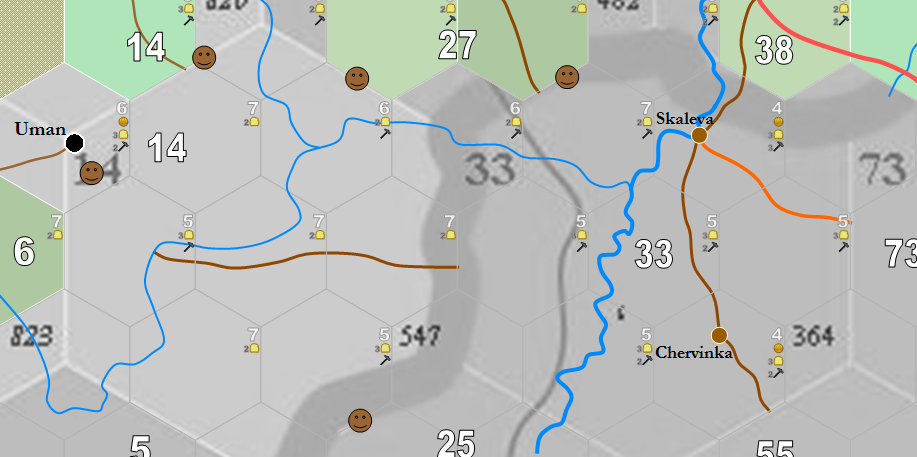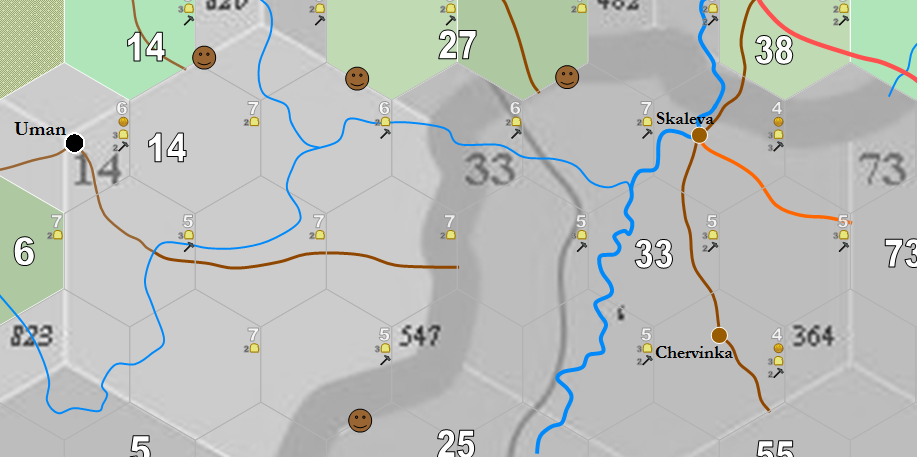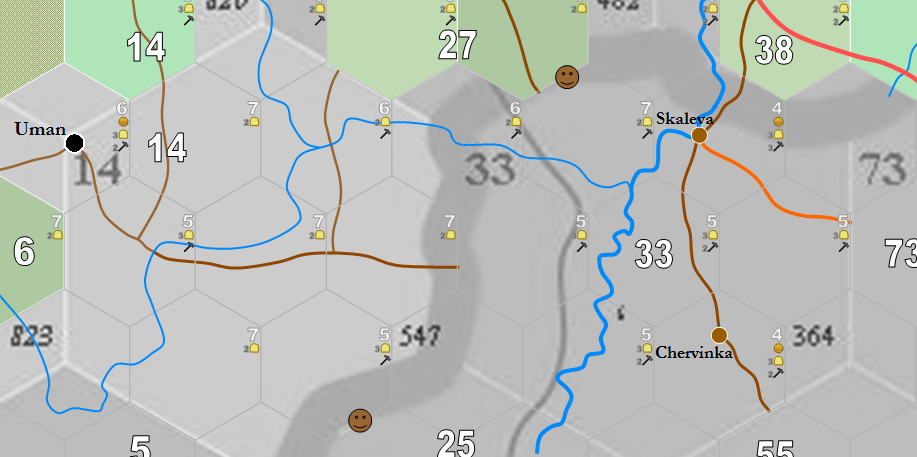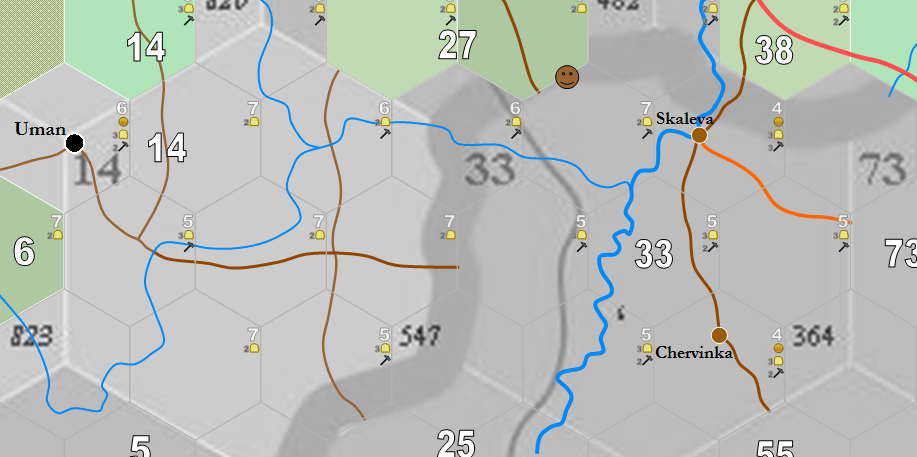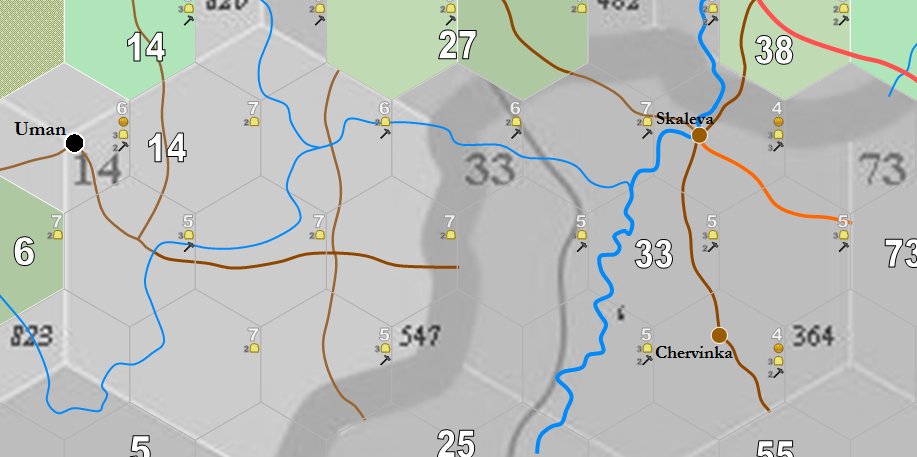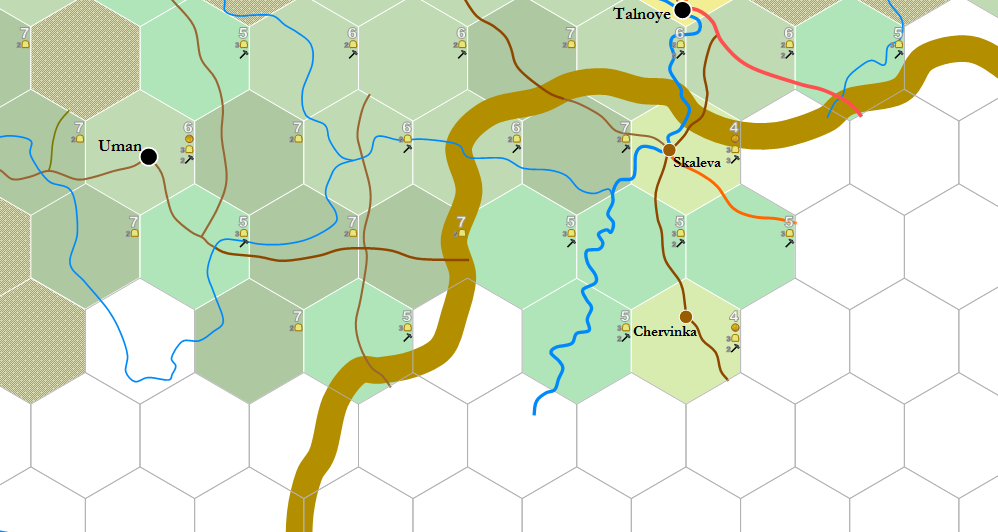Difference between revisions of "6-mile Hex Map"
Tao alexis (talk | contribs) |
Tao alexis (talk | contribs) |
||
| (35 intermediate revisions by the same user not shown) | |||
| Line 1: | Line 1: | ||
<div><ul> | <div><ul> | ||
| − | <li style="display: inline-block; float: right; margin-left: | + | <li style="display: inline-block; float: right; margin-left: 0px;"> [[File:Lower Bukovina.png|thumb|none|525px|6-mile map of Lower Bukovina, in central Ukraine.]]</li> |
| − | <li style="display: inline-block; float: right; margin-left: 15px; "> [[File:Divided 20-mile hex.jpg|thumb|none| | + | <li style="display: inline-block; float: right; margin-left: 15px; "> [[File:Divided 20-mile hex.jpg|thumb|none|280px|]]</li> |
</ul></div> | </ul></div> | ||
'''6-mile hex maps''' are zoomed-in maps derived from [[20-mile Hex Map|20-mile hex maps]], using a complex procedure of map drawing and random generation deriving from a map's [[Infrastructure|infrastructure]] and real-world topography and place names. | '''6-mile hex maps''' are zoomed-in maps derived from [[20-mile Hex Map|20-mile hex maps]], using a complex procedure of map drawing and random generation deriving from a map's [[Infrastructure|infrastructure]] and real-world topography and place names. | ||
__TOC__ | __TOC__ | ||
| − | The designation "6-mile" is an inaccurate description. | + | The designation "6-mile" is an inaccurate description. 6-mile hexes are derived from splitting a 20-mile hex, as shown in the image below, and are in fact 6.67 miles in diameter, not six. Nonetheless, the "6-mile" appellation is used as a simplification. |
== Generation Procedure == | == Generation Procedure == | ||
| − | Once the infrastructure of a given 20-mile hex | + | Once the infrastructure of a given 20-mile hex and its surrounding hexes has been determined, a rectangular "section" of 6-mile hexes can be created. |
[[File:Falling Rain Elevation Data.png|right|350px|thumb]] | [[File:Falling Rain Elevation Data.png|right|350px|thumb]] | ||
| − | This section includes two 20-mile hexes. | + | This section includes two 20-mile hexes. Each 20-mile hex, regardless of location, is designated based on its corresponding latitude and longitude. This allows us to precisely place the section on [https://earth.google.com/web/ Google Earth]. |
| − | The image on the right | + | The image on the right presents a dense array of numbers used to determine which hex corresponds to specific coordinates. These coordinates are organized by "rings," which indicate how many hexes a particular row is from the North Pole (ring 1). In the given image, "ring 143" means the North Pole is 142 × 20 miles away. The latitude of ring 143 falls between 48.51° N and 48.79° N. The left hex, containing the [[Settlement|settlement]] of Uman in Kiyev, is situated between 30.21° E and 30.62° E longitude. The right hex, located in Vassia, spans from 30.63° E to 31.04° E longitude. |
| − | These coordinates are in decimal format, | + | These coordinates are in decimal format, whereas Google Earth interprets coordinates in degrees, minutes, and seconds. To use them effectively, they must be converted and formatted in a way that allows for direct copying and pasting into the Google Earth search window. |
| − | + | To accomplish this, we draw out the four corners of both orange-coloured hexes in the table below, applying Excel formulas for conversion. A final column provides a "pastable" result, allowing instant input into Google Earth for precise navigation. Once entered, the program zooms in dynamically, revealing a landscape that may feature a dense forest, a rugged mountain, a quiet [[Village|village]], or an open field—bringing the map to life in real-world imagery. | |
{| class="wikitable" style="float:left; margin-right: 25px; text-align: center; background-color:#d4f2f2;" | {| class="wikitable" style="float:left; margin-right: 25px; text-align: center; background-color:#d4f2f2;" | ||
| Line 47: | Line 47: | ||
== Starting the 6-mile Map == | == Starting the 6-mile Map == | ||
| − | [[File:Uman 20-mile hexes.jpg|right| | + | [[File:Uman 20-mile hexes.jpg|right|560px|thumb|Starting out.]] |
As can be seen, the 6-mile hexes can be seen overlaid atop the 20-mile hexes beneath, one with the settlement of Uman and one without. To the west and north are 6-mile hexes that have been created. Large white numbers indicate the infrastructure for each 20-mile hex. These numbers are important for indicating the direction of roads into and out of the section we're mapping. | As can be seen, the 6-mile hexes can be seen overlaid atop the 20-mile hexes beneath, one with the settlement of Uman and one without. To the west and north are 6-mile hexes that have been created. Large white numbers indicate the infrastructure for each 20-mile hex. These numbers are important for indicating the direction of roads into and out of the section we're mapping. | ||
| − | Our first steps will be to provide basic information for these two hexes based on GoogleEarth's information. Take note of the blue rivers that have already been added to the map. These are ''guesses'' ... including the thicker blue river that is part of the 20-mile map underneath. We'll want to correct those river courses. | + | Our first steps will be to provide basic information for these two hexes based on GoogleEarth's information. Take note of the blue [[River |rivers]] that have already been added to the map. These are ''guesses''... including the thicker blue river that is part of the 20-mile map underneath. We'll want to correct those river courses. |
We also want to get a more accurate location for Uman. Occasionally the initial plotting is significantly incorrect. In addition, a series of brown dirt roads are also shown, cut-off at the edge of those hexes that are undone. The location of these roads is also a ''guess''. We don't know yet, except for Uman, what villages or towns might be here, not until we generate that information. For now, however, our first step is to address the section's topography. | We also want to get a more accurate location for Uman. Occasionally the initial plotting is significantly incorrect. In addition, a series of brown dirt roads are also shown, cut-off at the edge of those hexes that are undone. The location of these roads is also a ''guess''. We don't know yet, except for Uman, what villages or towns might be here, not until we generate that information. For now, however, our first step is to address the section's topography. | ||
==== Topography ==== | ==== Topography ==== | ||
| − | [[File:Uman with GoogleEarth.jpg|right| | + | [[File:Uman with GoogleEarth.jpg|right|560px|thumb|Adding in a visual component from GoogleEarth.]] |
To do that, we take a screen shot from GoogleEarth, of the part we've plotted; we paste that in paint, and cut out the visual rectangle that we need. That rectangle is then pasted into the 6-mile map above and placed as indicated, underneath the 6-mile hexes and cutting off the bottom and top tips of each hex. You can see that we're covering the tips of other hexes, above and below, as we do this. Some stretching of the GoogleEarth image does occur. | To do that, we take a screen shot from GoogleEarth, of the part we've plotted; we paste that in paint, and cut out the visual rectangle that we need. That rectangle is then pasted into the 6-mile map above and placed as indicated, underneath the 6-mile hexes and cutting off the bottom and top tips of each hex. You can see that we're covering the tips of other hexes, above and below, as we do this. Some stretching of the GoogleEarth image does occur. | ||
| + | |||
| + | Now we can correct for the narrow river on the left hand side and plot the bigger river on the right. Uman moves off into the corner of the map, with the name cut off (check it on GoogleEarth). In drawing the rivers there's no need to be absurdly precise. In the same way, we don't need to attempt to add every possible river. The goal isn't to produce an exact simulation of the Earth — if that were the case, we'd toss all this mapmaking and just run our game from GoogleEarth. No, what we want is to personalise our world, and create a map that we can pile notes on, if the players ever come this way. | ||
| + | |||
| + | [[File:Topography Done.jpg|right|560px|thumb|Topography completed.]] | ||
| + | We want to look for any lakes, and we want to check GoogleEarth itself for elevations by using the program's three-dimensional resolution. There's a very tiny lake on the right, but it's only 1.7 miles long (we can measure it with the path tool) and just 0.17 miles wide. Too small for us to deal with. As far as the possibility of hills, there are a few rolling places but nothing with an elevation change of more than 100-150 ft. Too small to add a hill symbol to the map. | ||
| + | |||
| + | With this done, we can get rid of the GoogleEarth reference, and recolor the background in grey tones. This makes it easier for us to see. Note the shift of Uman to the west. | ||
| + | |||
| + | === Hex Types === | ||
| + | Here is where we incorporate the infrastructure. Infrastructure is an indication of how developed, or how civilised, a given hex is. Each hex is assigned a "type," between 1 and 8. The lower the number, the more developed it is. | ||
| + | |||
| + | Type-1 hexes are very developed, containing no less than a commercial town and quite probably a big settlement. Type-8 hexes are completely undeveloped, with no recognised permanent residents living inside the hex. Our goal is to define each 6-mile hex according to it's type, so we can determine how many people live there, what sort of facilities it has, how much food it grows and what sort of social characteristics it has. | ||
| + | |||
| + | The left-hand side has 14 infrastructure, while the right has 33. Neither of these are very high. 100 infrastructure is a good strong number; 400 infrastructure indicates a highly developed part of the world. The right side of our section, that in Vassia, much more developed than the left, despite the presence of Uman. Uman is actually a very small village with only 213 people, founded in 1616 (only 34 years before the game world takes place). | ||
| + | |||
| + | These 14 points are distributed throughout the 20-mile hexes '''seven''' 6-mile hexes. These seven hexes are called a "[[Hex Group|hex group]]." Note that Ulan is in none of these. To save time, I've built an [https://docs.google.com/spreadsheets/d/1OD6XRL4yDHfS5N0F7SFIspfWpy72bYB2/edit#gid=1269951915 excel program] that generates the distribution automatically, which the reader can use. By putting 14 in the yellow box, I can generate which hex type occurs in which part of the hex group, as shown. | ||
| + | |||
| + | The image indicates that there are two [[Type-5 Hex|type-5]] hexes; one [[Type-6 Hex|type-6]]; and one [[Type-7 Hex|type-7]]. Putting these in order, the type-5 hexes go in the 1st and the 2nd positions — far left and bottom right. The type-6 goes in the 3rd position, top right. The remaining hexes are all type-7. | ||
| + | |||
| + | [[File:Hex Group.png|left|525px|thumb|Hex Group generation for the left-hand hex.]][[File:7-2b.jpg|right|60px|thumb]] | ||
| + | There are various small symbols that are used to designate the hex, once we know its type. On the right is a symbol for a typical type-7 hex. The number indicates the hex type, while the "[[Bread (symbol)|bread]]" symbol underneath indicates how much food the hex produces. 2 bread is not that much. | ||
| + | |||
| + | On the map, these symbols are very small. Two type-7 hexes can be seen in the examples above, on the left hand side. We add the appropriate symbols for each hex type, and then we generate the hex types that occur on the right hand side, that with 33 infrastructure. | ||
| + | |||
| + | === Places === | ||
| + | The results of this generation produce two [[Type-4 Hex|type-4]] hexes, four type-5 and one type-7. Hex types between 1 and 4 are awarded a minor population centre, so the two type-4 hexes are each given a village-sized place. An existing centre is taken from GoogleEarth, in the approximate place which the type-4 hex covers. | ||
| + | |||
| + | There are typically three to five places that can be chosen; zooming out on GoogleEarth reveals the most important, but in fact any of them might have existed in the 17th century. Most, or all, won't have, so which choice is made doesn't matter much. Again, this isn't about accuracy. Usually, a name that's easiest for the players to say can be chosen, but even this isn't always possible. | ||
| + | |||
| + | There's no sense in making up a name, as with so many parts of the world to be created, we'd have to invent thousands of such names. It's easier just to take a name from the map itself. Furthermore, this preserves a cultural integrity to a region. | ||
| + | |||
| + | [[File:Symbol Changes.png|right|560px|thumb]] | ||
| + | === Gaps === | ||
| + | The design so far, dropping the background image, shows there are four undesignated hexes coloured pale pink. A close inspection also shows that those hexes located along the larger river on the right have 1 more [[Hammer (symbol)|hammer]] than others of their same type. This is because a river at least 2 pts. wide, as this one is, gives a '''bonus of +1 hammer''' to hexes it runs through, due to increased waterpower. | ||
| + | |||
| + | Looking, the type-7 appears a duplicate of the type-6 two hexes to the left: 2 food and 1 hammer. There is a difference between these hexes, as indicated on the hammer link just given. The village of Skaleva has one more hammer than the village of Chervinka. The two type-5 hexes on the river have one more hammer than other type-5 hexes. | ||
| + | |||
| + | Calculating the pink hex next to Talnoye first, we add the total of all hexes surrounding the gap, which equals 33. Divided by six, this is 5.5; this gives a 50/50 chance of the hex being either a type-5 or type-6; we roll a die and find it's a type-6. We add the appropriate symbol and +1 hammer for the river. | ||
| + | |||
| + | The next hex to the left is calculated the same way; the surrounding hexes add up to 38, average 6.33. This could be either a type-6 or a type-7, but we weight it more towards being a 6. That is, on a roll of 1-4, this hex is a type-6; on a 5-6, it's a type-7. We roll and find it's a type-6. | ||
| + | |||
| + | The third hex, again to the left, is slightly different. It has a wilderness hex adjacent to it, so first we roll to determine if the gap hex is wilderness. We count the hexes clockwise, so that the wilderness hex is the "6" position. Rolling the die, we get a 4, so the gap isn't a wilderness hex. Thus we determine the nature of this gap hex the same way as before, counting the wilderness as type-8. The total adds up to 38; this is same as before. We roll and find this is also a type-6. | ||
| + | |||
| + | This leaves the gap hex with Uman in it. This can't be wilderness, so we skip that roll. We add the surrounding hexes and get a total of 39. Because Uman is a settlement, we don't roll, we automatically give it the best possible hex type, which is a type-6. Uman then gets a bonus +1 bread, +1 [[Coin (symbol)|coin]] and +1 hammer, because it's a settlement. This completes filling our gaps, and all the hex-types that can be known are designated. | ||
| + | |||
| + | == Routes == | ||
| + | [[File:Plotting Roads.png|right|560px|thumb]] | ||
| + | A description of laying out routes has been provided on the [[Roads & Routes#Creating Route Maps|roads and routes page]], but we'll recover this unusual matter here, having an particularly sparse example. Both hexes have such low infrastructures that they have only four outgoing routes. The 14 infrastructure hex has 1 dirt road and 3 cart tracks; because Uman is a population centre in a gap, outside the hex group, we can grant a fourth cart track for it. The 33 infrastructure hex has 1 cobbled road, 2 dirt roads and 1 cart track. | ||
| + | |||
| + | Creating symbols to indicate which routes go to which edges of the hex, I like coloured happy faces, as shown with the background restored. They can't be mistaken for any other part of the map. The best routes go to those adjacent hexes with the best infrastructure. With only 4 routes, we can see which hexes are overlooked for connecting routes. | ||
| + | |||
| + | Starting with the orange cobblestone road, we draw it from the edge of the hex, through the type-5 hex, connecting it with Skaleva (1), which is slightly more important than Chervinka and is the designated "hex centre." Then we connect the dirt road between Skaleva and the Talnoye hex (2), and because there's another designated dirt road south of Chervinka we can make this dirt road connect Skaleva and Chervinka (3). The last dirt road extends from the small 1 pt. river in the type-5 hex (4), the designated hex centre (and slightly more important than the other type-5, which has no river). We remove the happy faces we've used. | ||
| + | |||
| + | This leaves five cart tracks. Starting with Uman, we link up a cart track from there to the dirt road nearby (5). We connect a cart track to the hexes at the top, both left and right (6), using the right hand road to set up a crossroads for the dirt road connecting the other type-5 hex. We connect that road, finished up the hex (7). That leaves one more cart track, which we connect between the dirt road (adjusting it) in the infrastructure 27 hex to Skaleva (8). | ||
| + | |||
| + | These eight changes are arranged as a slide show; click on the first image and use the arrows to go forward and back. | ||
| + | |||
| + | <gallery mode=slideshow=175px style="text-align:left"> | ||
| + | File:Roads 1.png| | ||
| + | File:Roads 2.png| | ||
| + | File:Roads 3.png| | ||
| + | File:Roads 4.png| | ||
| + | File:Roads 5.png| | ||
| + | File:Roads 6.png| | ||
| + | File:Roads 7.png| | ||
| + | File:Roads 8.png| | ||
| + | </gallery> | ||
| + | |||
| + | The dead ends are intentional. They lead to [[Hamlets|hamlets]], not shown on the map, and also allow further progress for travellers along foot paths, utterly impractical for carts. These are also not shown on the map, as they're everywhere people are. | ||
| + | |||
| + | == Colour == | ||
| + | The very last step is to add in the border between Kiyev and Vassia, and to colour the hexes. Each hex type has it's own colour, so the general "feel" of the hex map can be understood at a glance. Brighter colours mean people; dull green means backcountry farmlands. | ||
| + | |||
| + | [[File:Finished Section.png|right|700px|thumb]] | ||
| + | Showing, then, is the finished product, without the background visible. The process seems excessively complicated, but in actual fact much of this is the need for unfamiliar technical terms to describe what's going on. Once two or three hundred sections are completed (I've done more than 700), the procedure becomes quite familiar so that it's easy to continue with section after section. | ||
| + | |||
| + | For those who may be interested in more content about mapmaking, since Alexis' blog, [https://tao-mapmaking.blogspot.com/ Tao's Mapmaking]. | ||
| + | |||
| + | == Conclusion == | ||
| + | The process can be repeated with patience to produce truly startling extensive game maps that makes a powerful impression with players. As more sections are generated, the realism of the world comes to life and the setting grows in continuity and depth. | ||
| + | |||
| + | |||
| + | See [[6-mile Sheet Maps]] | ||
| + | |||
| + | [[Category: Reviewed]] | ||
Latest revision as of 17:39, 19 March 2025
6-mile hex maps are zoomed-in maps derived from 20-mile hex maps, using a complex procedure of map drawing and random generation deriving from a map's infrastructure and real-world topography and place names.
Contents
The designation "6-mile" is an inaccurate description. 6-mile hexes are derived from splitting a 20-mile hex, as shown in the image below, and are in fact 6.67 miles in diameter, not six. Nonetheless, the "6-mile" appellation is used as a simplification.
Generation Procedure
Once the infrastructure of a given 20-mile hex and its surrounding hexes has been determined, a rectangular "section" of 6-mile hexes can be created.
This section includes two 20-mile hexes. Each 20-mile hex, regardless of location, is designated based on its corresponding latitude and longitude. This allows us to precisely place the section on Google Earth.
The image on the right presents a dense array of numbers used to determine which hex corresponds to specific coordinates. These coordinates are organized by "rings," which indicate how many hexes a particular row is from the North Pole (ring 1). In the given image, "ring 143" means the North Pole is 142 × 20 miles away. The latitude of ring 143 falls between 48.51° N and 48.79° N. The left hex, containing the settlement of Uman in Kiyev, is situated between 30.21° E and 30.62° E longitude. The right hex, located in Vassia, spans from 30.63° E to 31.04° E longitude.
These coordinates are in decimal format, whereas Google Earth interprets coordinates in degrees, minutes, and seconds. To use them effectively, they must be converted and formatted in a way that allows for direct copying and pasting into the Google Earth search window.
To accomplish this, we draw out the four corners of both orange-coloured hexes in the table below, applying Excel formulas for conversion. A final column provides a "pastable" result, allowing instant input into Google Earth for precise navigation. Once entered, the program zooms in dynamically, revealing a landscape that may feature a dense forest, a rugged mountain, a quiet village, or an open field—bringing the map to life in real-world imagery.
| Description | Degrees | Minutes | Direction | Seconds | Four Points | Pastable |
|---|---|---|---|---|---|---|
| low latitude | 48 | 51 | N | =C2*0.6 | =$B$2&" "&$E$2&"'"&$D$2&", "&$B$4&" "&$E$4&"'"&$D$4 | 48 30.6'N, 30 12.6'E |
| high latitude | 48 | 79 | N | =C3*0.6 | =$B$3&" "&$E$3&"'"&$D$3&", "&$B$4&" "&$E$4&"'"&$D$4 | 48 47.4'N, 30 12.6'E |
| low longitude | 30 | 21 | E | =C4*0.6 | =$B$2&" "&$E$2&"'"&$D$2&", "&$B$5&" "&$E$5&"'"&$D$5 | 48 30.6'N, 31 2.4'E |
| Bournemouth | 31 | 4 | E | =C5*0.6 | =$B$3&" "&$E$3&"'"&$D$3&", "&$B$5&" "&$E$5&"'"&$D$5 | 48 47.4'N, 31 2.4'E |
Plotting the Section
Following the first search, we find ourselves in a field on the edge of a small Ukraine village. We go up to the tool bar and select a "circle" tool and we draw a circle around the section corner point. We plug in each plot point next, making circles as we go, laying out the connect-the-dots set up for drawing a rectangle.
Using the small red circles, we use the "path" tool next to the circle tool and connect the dots, creating our rectangle section. This corresponds with the two 20-mile hexes to be expanded.
This section of GoogleEarth gets used for a number of things, so it needs to be saved. On the side toolbar of GoogleEarth, there's a heading called "Temporary Places." The new "Path Measure" we created can be saved by right clicking it. Once it jumps to the "My Places" heading, the four circle measures can be deleted. They've done their job. This part of the process can be left for a moment while we move onto getting the 6-mile map ready.
Starting the 6-mile Map
As can be seen, the 6-mile hexes can be seen overlaid atop the 20-mile hexes beneath, one with the settlement of Uman and one without. To the west and north are 6-mile hexes that have been created. Large white numbers indicate the infrastructure for each 20-mile hex. These numbers are important for indicating the direction of roads into and out of the section we're mapping.
Our first steps will be to provide basic information for these two hexes based on GoogleEarth's information. Take note of the blue rivers that have already been added to the map. These are guesses... including the thicker blue river that is part of the 20-mile map underneath. We'll want to correct those river courses.
We also want to get a more accurate location for Uman. Occasionally the initial plotting is significantly incorrect. In addition, a series of brown dirt roads are also shown, cut-off at the edge of those hexes that are undone. The location of these roads is also a guess. We don't know yet, except for Uman, what villages or towns might be here, not until we generate that information. For now, however, our first step is to address the section's topography.
Topography
To do that, we take a screen shot from GoogleEarth, of the part we've plotted; we paste that in paint, and cut out the visual rectangle that we need. That rectangle is then pasted into the 6-mile map above and placed as indicated, underneath the 6-mile hexes and cutting off the bottom and top tips of each hex. You can see that we're covering the tips of other hexes, above and below, as we do this. Some stretching of the GoogleEarth image does occur.
Now we can correct for the narrow river on the left hand side and plot the bigger river on the right. Uman moves off into the corner of the map, with the name cut off (check it on GoogleEarth). In drawing the rivers there's no need to be absurdly precise. In the same way, we don't need to attempt to add every possible river. The goal isn't to produce an exact simulation of the Earth — if that were the case, we'd toss all this mapmaking and just run our game from GoogleEarth. No, what we want is to personalise our world, and create a map that we can pile notes on, if the players ever come this way.
We want to look for any lakes, and we want to check GoogleEarth itself for elevations by using the program's three-dimensional resolution. There's a very tiny lake on the right, but it's only 1.7 miles long (we can measure it with the path tool) and just 0.17 miles wide. Too small for us to deal with. As far as the possibility of hills, there are a few rolling places but nothing with an elevation change of more than 100-150 ft. Too small to add a hill symbol to the map.
With this done, we can get rid of the GoogleEarth reference, and recolor the background in grey tones. This makes it easier for us to see. Note the shift of Uman to the west.
Hex Types
Here is where we incorporate the infrastructure. Infrastructure is an indication of how developed, or how civilised, a given hex is. Each hex is assigned a "type," between 1 and 8. The lower the number, the more developed it is.
Type-1 hexes are very developed, containing no less than a commercial town and quite probably a big settlement. Type-8 hexes are completely undeveloped, with no recognised permanent residents living inside the hex. Our goal is to define each 6-mile hex according to it's type, so we can determine how many people live there, what sort of facilities it has, how much food it grows and what sort of social characteristics it has.
The left-hand side has 14 infrastructure, while the right has 33. Neither of these are very high. 100 infrastructure is a good strong number; 400 infrastructure indicates a highly developed part of the world. The right side of our section, that in Vassia, much more developed than the left, despite the presence of Uman. Uman is actually a very small village with only 213 people, founded in 1616 (only 34 years before the game world takes place).
These 14 points are distributed throughout the 20-mile hexes seven 6-mile hexes. These seven hexes are called a "hex group." Note that Ulan is in none of these. To save time, I've built an excel program that generates the distribution automatically, which the reader can use. By putting 14 in the yellow box, I can generate which hex type occurs in which part of the hex group, as shown.
The image indicates that there are two type-5 hexes; one type-6; and one type-7. Putting these in order, the type-5 hexes go in the 1st and the 2nd positions — far left and bottom right. The type-6 goes in the 3rd position, top right. The remaining hexes are all type-7.
There are various small symbols that are used to designate the hex, once we know its type. On the right is a symbol for a typical type-7 hex. The number indicates the hex type, while the "bread" symbol underneath indicates how much food the hex produces. 2 bread is not that much.
On the map, these symbols are very small. Two type-7 hexes can be seen in the examples above, on the left hand side. We add the appropriate symbols for each hex type, and then we generate the hex types that occur on the right hand side, that with 33 infrastructure.
Places
The results of this generation produce two type-4 hexes, four type-5 and one type-7. Hex types between 1 and 4 are awarded a minor population centre, so the two type-4 hexes are each given a village-sized place. An existing centre is taken from GoogleEarth, in the approximate place which the type-4 hex covers.
There are typically three to five places that can be chosen; zooming out on GoogleEarth reveals the most important, but in fact any of them might have existed in the 17th century. Most, or all, won't have, so which choice is made doesn't matter much. Again, this isn't about accuracy. Usually, a name that's easiest for the players to say can be chosen, but even this isn't always possible.
There's no sense in making up a name, as with so many parts of the world to be created, we'd have to invent thousands of such names. It's easier just to take a name from the map itself. Furthermore, this preserves a cultural integrity to a region.
Gaps
The design so far, dropping the background image, shows there are four undesignated hexes coloured pale pink. A close inspection also shows that those hexes located along the larger river on the right have 1 more hammer than others of their same type. This is because a river at least 2 pts. wide, as this one is, gives a bonus of +1 hammer to hexes it runs through, due to increased waterpower.
Looking, the type-7 appears a duplicate of the type-6 two hexes to the left: 2 food and 1 hammer. There is a difference between these hexes, as indicated on the hammer link just given. The village of Skaleva has one more hammer than the village of Chervinka. The two type-5 hexes on the river have one more hammer than other type-5 hexes.
Calculating the pink hex next to Talnoye first, we add the total of all hexes surrounding the gap, which equals 33. Divided by six, this is 5.5; this gives a 50/50 chance of the hex being either a type-5 or type-6; we roll a die and find it's a type-6. We add the appropriate symbol and +1 hammer for the river.
The next hex to the left is calculated the same way; the surrounding hexes add up to 38, average 6.33. This could be either a type-6 or a type-7, but we weight it more towards being a 6. That is, on a roll of 1-4, this hex is a type-6; on a 5-6, it's a type-7. We roll and find it's a type-6.
The third hex, again to the left, is slightly different. It has a wilderness hex adjacent to it, so first we roll to determine if the gap hex is wilderness. We count the hexes clockwise, so that the wilderness hex is the "6" position. Rolling the die, we get a 4, so the gap isn't a wilderness hex. Thus we determine the nature of this gap hex the same way as before, counting the wilderness as type-8. The total adds up to 38; this is same as before. We roll and find this is also a type-6.
This leaves the gap hex with Uman in it. This can't be wilderness, so we skip that roll. We add the surrounding hexes and get a total of 39. Because Uman is a settlement, we don't roll, we automatically give it the best possible hex type, which is a type-6. Uman then gets a bonus +1 bread, +1 coin and +1 hammer, because it's a settlement. This completes filling our gaps, and all the hex-types that can be known are designated.
Routes
A description of laying out routes has been provided on the roads and routes page, but we'll recover this unusual matter here, having an particularly sparse example. Both hexes have such low infrastructures that they have only four outgoing routes. The 14 infrastructure hex has 1 dirt road and 3 cart tracks; because Uman is a population centre in a gap, outside the hex group, we can grant a fourth cart track for it. The 33 infrastructure hex has 1 cobbled road, 2 dirt roads and 1 cart track.
Creating symbols to indicate which routes go to which edges of the hex, I like coloured happy faces, as shown with the background restored. They can't be mistaken for any other part of the map. The best routes go to those adjacent hexes with the best infrastructure. With only 4 routes, we can see which hexes are overlooked for connecting routes.
Starting with the orange cobblestone road, we draw it from the edge of the hex, through the type-5 hex, connecting it with Skaleva (1), which is slightly more important than Chervinka and is the designated "hex centre." Then we connect the dirt road between Skaleva and the Talnoye hex (2), and because there's another designated dirt road south of Chervinka we can make this dirt road connect Skaleva and Chervinka (3). The last dirt road extends from the small 1 pt. river in the type-5 hex (4), the designated hex centre (and slightly more important than the other type-5, which has no river). We remove the happy faces we've used.
This leaves five cart tracks. Starting with Uman, we link up a cart track from there to the dirt road nearby (5). We connect a cart track to the hexes at the top, both left and right (6), using the right hand road to set up a crossroads for the dirt road connecting the other type-5 hex. We connect that road, finished up the hex (7). That leaves one more cart track, which we connect between the dirt road (adjusting it) in the infrastructure 27 hex to Skaleva (8).
These eight changes are arranged as a slide show; click on the first image and use the arrows to go forward and back.
The dead ends are intentional. They lead to hamlets, not shown on the map, and also allow further progress for travellers along foot paths, utterly impractical for carts. These are also not shown on the map, as they're everywhere people are.
Colour
The very last step is to add in the border between Kiyev and Vassia, and to colour the hexes. Each hex type has it's own colour, so the general "feel" of the hex map can be understood at a glance. Brighter colours mean people; dull green means backcountry farmlands.
Showing, then, is the finished product, without the background visible. The process seems excessively complicated, but in actual fact much of this is the need for unfamiliar technical terms to describe what's going on. Once two or three hundred sections are completed (I've done more than 700), the procedure becomes quite familiar so that it's easy to continue with section after section.
For those who may be interested in more content about mapmaking, since Alexis' blog, Tao's Mapmaking.
Conclusion
The process can be repeated with patience to produce truly startling extensive game maps that makes a powerful impression with players. As more sections are generated, the realism of the world comes to life and the setting grows in continuity and depth.
